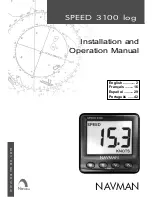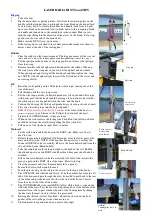
With careful planning (attenuating and off-
setting the incoming CV) one can move the
shortened sequence around, which greatly
enhances Moskwa II’s already vast sequence
mangling functionality.
The fourth row deals with one function only.
The
step repeat
10
input and button
11
control the step repeat function. When the
button is pressed and held, or the input re-
ceives a gate, the currently active step is re-
peated until the button is released or the gate
at the
step repeat
input is low.
All inputs accept CV in the +/-10V range. The
exact range of voltages needed to sweep the
full range of the parameter depends on the
position of the knob on the connected Moskwa
II unit. For example, with the
rate
knob set in
the middle position, a +/-5V LFO will sweep
the whole range. On the other hand, with the
knob set at minimum, one would need a 0-10V
signal to sweep the entire range.
The bottom half of the front panel is occupied
by eight
step trig/bit out
outputs
12
and
respective switch
13
. Their functionality is
explained in the section below.
OUTPUTS 1-8
The eight
step trig/bit out
outputs cor-
respond to the Moskwa II sequence steps 1-8.
The switch alternates between gate output
and bit output modes. In the gate output
mode, the outputs send gates for the corre-
sponding steps 1-8. When the step is inactive,
there is no signal at its corresponding Os-
tankino II output 1-8 (depending on the set-
ting on the Moskwa II module). The outputs
send voltages within the range of 0-5V.
In the bit output mode, outputs 1-8 assume a
very different role (see: "Expandability: Leib
-
niz Subsystem" section below).
EXPANDABILITY: CHAIN MODE
When two Moskwa II units are chained togeth-
er, the Ostankino II expander controls only the
one to which it is connected. Also, the
clk,
step trig,
and
bit outputs
correspond to
the parameters of the Moskwa II module to
which the Ostankino II expander is connected.
EXPANDABILITY: LEIBNIZ SUBSYSTEM
At the bottom of the back of the module, the
user will find a 10-pin connector for the Xaoc
Leibniz Binary Subsystem (see: fig. 2). It sends
CV set by Moskwa II’s potentiometer but con-
verted to 8-bit values for further processing,
e.g. by Xaoc Drezno module. The signal pres
-
ent at the Leibniz Binary Subsystem connector
depends on the position of the
step trig/bit
out
switch on the front panel.
With the switch set to the
step trig
position,
the Leibniz connector outputs gates for each
sequence step consecutively.
4
























